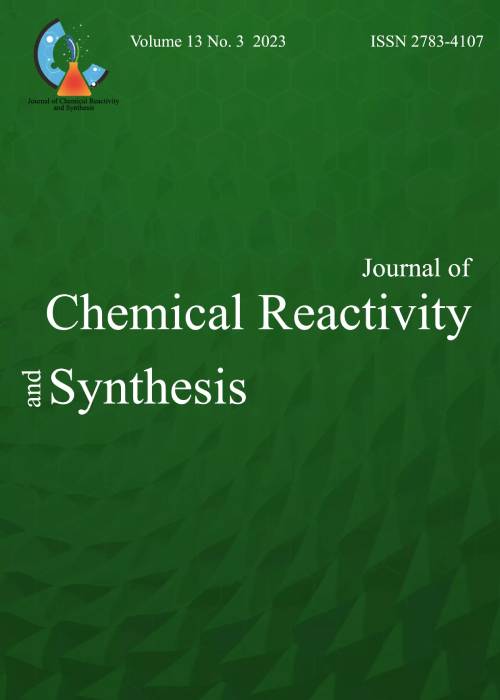فهرست مطالب
Journal of Chemical Reactivity and Synthesis
Volume:10 Issue: 2, Spring 2020
- تاریخ انتشار: 1398/02/24
- تعداد عناوین: 6
-
Pages 51-57
Nanocomposite membranes were prepared by coating a porous Polyethersulfone (PES) support containing 8-hydroxyquinoline (as complexing agent) with poly (vinyl alcohol) (PVA)/Fe3O4 nanocomposite solution. The prepared membranes were applied for removal of Zn(II) ions from water. The effect of membrane modification on the membranes performance for removal of metal ions was investigated. The results indicated that presence of ligand and Fe3O4 nanoparticles in the membrane structure enhanced the ions rejection. The prepared samples were characterized by scanning electron microscopy. SEM images indicated appropriate distribution of nanoparticles in the polymeric matrix.
Keywords: Colloidal synthesis, Ni-doped ZnSe NCs, Core, shell structures, Photoluminescence emission -
Pages 58-66The BiFeO3 perovskite-type oxide was synthesized using the citrate gel method and the catalytic activity of the BiFeO3 was assessed in a multicomponent reaction of benzil, an aromatic aldehyde, and an amine in the presence of ammonium acetate under solvent-free conditions. The physical and chemical properties of the catalyst were determined using X-ray diffraction, Fourier transform infrared spectroscopy, scanning electron microscopy, and Energy dispersive X-ray spectroscopy and Imidazole products were identified by comparing their melting points with already reported papers. SEM illustrated a smooth surface with a uniform morphology for the catalyst. Meanwhile, XRD indicates two phases of BiFeO3 and Bi2Fe4O9 at the same time. Moreover, IR and EDS both showed the absence of any impurities in the mentioned catalyst. The experimental data revealed excellent catalytic performance for BiFeO3 in absence of any solvents. Therefore, BiFeO3 can be used as an efficient and green catalyst for the synthesis of 1,2,4,5-tetrasubstituted Imidazoles.Keywords: BiFeO3, Multicomponent reactions, Perovskites
-
Pages 67-74
Poly 4-(2,3-dihydro[3,4-6][1,4][dioxin-5-yl) aniline (EDOT-Ani) is an interesting novel monomer which can be used as an electrode in fabrication of dye synthesized solar cells. In this paper a DFT method with B3LYP/6-31G* level of theory was used for investigating the structural, electronic and optical properties of different configurations of 4-EDOT-Ani. The structural parameters were calculated and indicated that the EDOT-Aniline has a benzoid structure. Gibbs free energy calculations show that gauch- anti configuration is the most energetically stable structure. The HOMO-LUMO gaps were calculated their counters were interpreted. The IR spectrum was simulated and show good correlation with experimental values. Finally, TDDFT calculations were used for obtaining the UV spectra of all configurations.
Keywords: Copolymer, EDOT, DFT, optical properties -
Pages 75-81
This theoretical study investigated the oxidation reaction mechanism of acetonitrile as a volatileorganic compound by nitrogen trioxide in formation of secondary organic aerosol. The B3LYP level with 6-311++G (3df, 3pd) basis set was used to optimize geometries of reactants, products, and transition states. One product was obtained and the reaction pathway of the product was discussed and potential energy surface was plotted. The rate constant calculated at atmospheric pressure over the temperature range 300-2500 K. Finally formation of secondary organic aerosol has been discussed.
Keywords: VOC, SOA, Acetonitrile, nitrogen trioxide, potential energy surface -
Pages 82-86
In this paper we experimentally worked on hydrogen storage on G-C3N4 in ambient temperature and 20 bar pressure. Also we determined thermodynamical properties of hydrogen adsorption. We synthesized pure G-C3N4 by Urea Precursor and it proved by XRD and FT-IR spectra. Results show that the pure G-C3N4 adsorption isotherm matched to Freundlich adsorption isotherm and ΔHad ,ΔGad and ΔSad obtained about (-27 kj/mol), (+21 kj/mol) and (-161 j/k) respectively. Result showed pure G-C3N4 have low hydrogen storage and could not consider as candidate for hydrogen storage materials and must equip with other materials like metal oxide, transitional metal and to promote capacity of G-C3N4 compounds for fuel cell application.
Keywords: Hydrogen, G-C3N4, Storage -
Pages 87-93
Among various CuInS2-rerlated heterojunctions, it is expected that CIS-based p−n junctions are high-performance photo-active electrodes. Herein, both n-type and p-type CuInS2 thin films were synthesized via facile successive ion layer adsorption and reaction (SILAR) method, using aqueous (A-CIS) and mathanolic (M-CIS) SILAR solutions, respectively. Based on UV-visible transmission spectra, M-CIS thin films were more transparent with larger band gap energy (1.6 eV) than A-CIS thin films (1.5 eV). The A1-mode Raman peak of M-CIS thin film was located at 293 cm-1 which has a red shift of 5 cm-1 as compared to A-CIS one, indicating that M-CIS has smaller CuInS2 nanoparticles. The Mott-Schottky plots revealed that A-CIS is an n-type semiconductor, while M-CIS thin films have p-type semiconducting behavior, which is due to different Cu/In ratio in these thin films. The obtained results can be very useful to prepared CIS-based p-n junctions toward high performance solar-based devices.
Keywords: CuInS2 thin film, Heterojunction, solar- based devices


